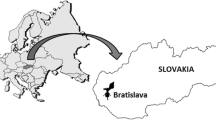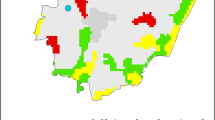Abstract
Temporal variation of airborne fern spore concentrations in Bratislava during the three years (2019‒2021) was studied using a Hirst-type aerospore sampler. Fern spores were frequently present in the air but at low concentrations. The total annual spore concentration recorded was 523 spores/m3, belonging to eight spore types of fern plants (Asplenium sp., Athyrium sp., Botrychium sp., Cystopteris sp., Dryopteris sp., Matteuccia struthiopteris and Polypodium sp. of ferns and Equisetum sp. of horsetails). The taxa contributing the highest spore concentration were Dryopteris (52% of the total; mean value for the three analysed years) and Athyrium (26% of the total). Species of these two genera are abundant in the fragments of natural woodland within the city. The season period from July to August shows the most intense airborne spore dispersal process in each analysed year. Although the average daily spore concentration did not exceed 1 spore/m3 during the period analysed, we recorded values of up to 15 spores/m3 on several days. Since fern spores are one of the allergenic airborne bioparticles, it is assumed that their inhalation at this concentration may already induce inhalation allergy symptoms in sensitive individuals. The relationships between selected weather variables and mean daily fern spore concentrations for Dryopteris and Athyrium were evaluated through Spearman’s correlation test. The spore concentrations were positively associated with air temperature and/or sunshine and negatively with relative air humidity.








Similar content being viewed by others
Data Availability
All data generated or analysed during this study are included in this published article and its supplementary information file.
References
Bunnag C, Dhorranintra B, Limsuvan S (1989) Ferns and their allergenic importance: skin and nasal provocation tests to fern spore extract in allergic and non-allergic patients. Ann Allergy 62:554–558. https://doi.org/10.1054/bjoc.2000.1204
Burge HA, Rogers CA (2000) Outdoor allergens. Environ Health Perspect 108:653–659. https://doi.org/10.1289/ehp.00108s4653
Caulton E, Keddie S, Carmichael R, Sales J (2000) A ten year study of the incidence of spores of bracken (Pteridium aquilinum (L.) Kuhn.) in an urban rooftop ar stream in south east Scotland. Aerobiologia 16:29–33. https://doi.org/10.1023/a:1007674431125
Chew FT, Lim SH, Shang HS, Siti Dahlia MD, Goh DYT, Lee BW, Tan HTW, Tan TK (2000) Evaluation of the allergenicity of tropical pollen and airborne spores in Singapore. Allergy 55:340–347. https://doi.org/10.1034/j.1398-9995.2000.00308.x
Choi Y-J, Lee K-S, Oh J-W, Kim K-R, Lee Y-S (2020) Revision of pollen threshold levels for oak, pine, ragweed, and Japanese hop in Seoul metropolitan area. World Allergy Organization Journal 13:108–109. https://doi.org/10.1016/j.waojou.2020.100288
Christenhusz MJM, Chase MW (2014) Trends and concepts in fern classification. Ann Botany 113:571–594. https://doi.org/10.1093/aob/mct299
Conant DS (1978) A radioisotope technique to measure spore dispersal of the tree fern Cyathea arborea SM. Pollen Spores 20:580–593
Essien BC, Agwu COC, Ige OE (2015) A study of airborne bioparticles of Anyigba environment, Kogi State, Nigeria. J Biol Chem Research 32:152–159
Feráková V, Jarolímek I (2011) Bratislava. In: Kelcey JG, Müller N (eds) Plants and habitats of European cities. Springer, New York, pp 79–129
Futák J (1966) Flóra Slovenska 2. Flora of Slovakia 2. Vydavateľstvo Slovenskej akadémie vied, Bratislava, 352 p. (in Slovak)
Galán C, Cariñanos P, Alcázar P, Domínguez-Vilches E (2007) Spanish aerobiology network (REA): Management and quality manual. Servicio de publicaciones de la Universidad de Córdoba, Córdoba
Galán C, Smith M, Thibaudon M, Frenguelli G, Oteros J, Gehrig R et al (2014) Pollen monitoring: Minimum requirements and reproducibility of analysis. Aerobiologia 30:385–395. https://doi.org/10.1007/s10453-014-9335-5
Geller-Bernstein C, Keynan N, Bejerano A (1987) Positive skin tests to fern spore extracts in atopic patients. Ann Allergy 58:125–127
Gómez-Noguez F, Pérez-García B, Mehltreter K, Orozco-Segovia A, Rosas-Pérez I (2016) Spore mass and morphometry of some fern species. Flora 223:99–105. https://doi.org/10.1016/J.FLORA.2016.05.003
Gómez-Noguez F, Pérez-García B, Mendoza-Ruiz A, Orozco-Segovia A (2017) Fern and lycopod spores rain in a cloud forest of Hidalgo. Mexico Aerobiologia 33:23–35. https://doi.org/10.1007/s10453-016-9447-1
Haratym W, Weryszko-Chmielewska E, Dmitruk M (2014) An analysis of the content of Pteridophyta spores in aeroplankton of Lublin (2013–2014). Acta Agrobotanica 67:21–28. https://doi.org/10.5586/aa.2014.041
Hirst JM (1952) An automatic volumetric spore trap. Ann Appl Biol 39:257–265. https://doi.org/10.1111/j.1744-7348.1952.tb00904.x
Hossain MS, Pasha MK (2012) Airborne fungal and pteridophytic spores in Chittagong University campus, Chittagong. J Asiat Soc Bangladesh Sci 38:119–124. https://doi.org/10.3329/jasbs.v38i1.15327
Huang T-C, Huang S-Y, Hsiao A, Chen S-H (2008) Aeropalynological study of Kinmen Island. Taiwan Taiwania 53:369–382. https://doi.org/10.6165/TAI.2008.53(4).369
Ingold CT (1965) Spore liberation. Clarendon Press, Oxford, p 210
Kasprzyk I (2004) Airborne pollen of entomophilous plants and spores of pteridophytes in Rzeszów and its environs (SE Poland). Aerobiologia 20:217–222. https://doi.org/10.1007/S10453-004-1185-0
Kreft H, Jetz W, Mutke J, Barthlott W (2010) Contrasting environmental and regional effects on global pteridophyte and seed plant diversity. Ecography 33:408–419. https://doi.org/10.1111/j.1600-0587.2010.06434.x
Lacey ME, McCartney HA (1994) Measurement of airborne concentrations of spores of bracken (Pteridium aquilinum). Grana 33:91–93. https://doi.org/10.1080/00173139409427838
Lacey ME, West JS (2006) The air spora. The manual forcatching and identifying airborne biological particles. Dordrecht, the Netherlands: Springer-Verlag Gmbh. https://doi.org/10.1111/j.1365-3059.2007.01610.x
Moran RC (2008) Neotropical genera of ferns and lycophytes: a guide for students. New York Botanical Garden, New York
Nilsson S, Persson S (1981) Tree pollen spectra in the Stockholm region (Sweden), 1973–1980. Grana 20:179–182. https://doi.org/10.1080/00173138109427661
Ong TC, Lim SH, Chen X, Dali SDM, Tan HTW, Lee BW, Chew FT (2012) Fern spore and pollen air spora profile of Singapore. Aerobiologia 28:135–151. https://doi.org/10.1007/s10453-011-9217-z
Peck JH, Peck CJ, Farrar DR (1990) Influences of life history attributes on formation of local and distant fern populations. Am Fern J 80:126–142. https://doi.org/10.2307/1547200
PPG I (2016) A community-derived classification for extant lycophytes and ferns. J Syst Evol 54:563–603. https://doi.org/10.1111/jse.12229
Rodríguez de la Cruz DR, Molino S, Prada C, Ruiz SS, Agudo JAS, Seral A, Ferreira RV (2021) Contribución al conocimiento de las esporas de licófitos y pteridófitos en la atmósfera de la península Ibérica. Bot Complut 45:1–9. https://doi.org/10.5209/BOCM.74315
Rodríguez de la Cruz DR, Sánchez-Reyes E, Sánchez-Sánchez J (2009) Effects of meteorological factors on airborne bracken (Pteridium aquilinum (L.) Kuhn.) spores in Salamanca (middle-west Spain). Int J Biometeorol 53:231–237. https://doi.org/10.1007/s00484-009-0208-5
Rose JP, Dassler CL (2017) Spore production and dispersal in two temperate fern species, with an overview of the evolution of spore production in ferns. Am Fern J 107:136–155. https://doi.org/10.1640/0002-8444-107.3.136
Schneller JJ (1975) Untersuchungen an einheimischen Farnen, insbesondere der Dryopteris filix-mas Gruppe 3. Teil Okologische Unters Ber Schweiz Bot Ges 85:110–159. https://doi.org/10.5169/seals-60166
Simán SE, Povey AC, Ward TH, Margison GP, Sheffield E (2000) Fern spore extracts can damage DNA. Br J Cancer 83:69–73. https://doi.org/10.1054/bjoc.2000.1204
Singh J, Devi S (1990) New approach to the study of allergenic fern sporoderm. Prod Indian Natn Sci Acad 56:299–304. https://doi.org/10.5586/aa.2014.041
Stanová V, Valachovič I (2002) Katalóg biotopov Slovenska. Catalogue of biotopes of Slovakia. DAPHNE – Inštitút aplikovanej ekológie, Bratislava, 225 p. (in Slovak)
Tomšík P (2014) Ferns and Lycopods - a potential treasury of anticancer agents but also a carcinogenic hazard. Phytother Res 28:798–810. https://doi.org/10.1002/ptr.5070
Tryon AF, Lugardon BI (1991) Spores of the Pteridophyta: Surface, wall structure and diversity based on electron microscope studies. Springer-Verlag, New York, USA
Wolf PG, Schneider H, Ranker TA (2001) Geographic distributions of homosporous ferns: Does dispersal obscure evidence of vicariance? J Biogeogr 28:263–270. https://doi.org/10.1046/j.1365-2699.2001.00531.x
Zenkteler E (2012) Morphology and peculiar reatures of spores of fern species occurrng in Poland. Acta Agrobotanica 65:3–10. https://doi.org/10.5586/AA.2012.053
Acknowledgements
The authors acknowledge both the Division of Meteorology and Climatology (Faculty of Mathematics, Physics and Informatics of Comenius University in Bratislava) for providing meteorological data used in this paper.
Funding
This study was supported by Grant Agency VEGA (Bratislava), Grant No. 1/0180/22.
Author information
Authors and Affiliations
Contributions
Jana Ščevková: Conceptualization, Formal analysis, Methodology, Supervision, Validation, Visualization, Writing - original draft, Writing - review & editing. Zuzana Vašková: Data curation, Formal analysis, Investigation, Visualization, Writing - review & editing. Jozef Dušička: Data curation, Methodology, Writing - review & editing. Michal Hrabovský: Validation, Visualization, Writing - review & editing.
Corresponding author
Ethics declarations
Competing interests
The authors declare that they have no competing interests.
Ethics approval and consent to participate
Not applicable.
Consent for publication
Not applicable.
Additional information
Publisher’s Note
Springer Nature remains neutral with regard to jurisdictional claims in published maps and institutional affiliations.
Rights and permissions
About this article
Cite this article
Ščevková, J., Vašková, Z., Dušička, J. et al. Fern spores: neglected airborne bioparticles threatening human health in urban environments. Urban Ecosyst 25, 1825–1838 (2022). https://doi.org/10.1007/s11252-022-01263-2
Accepted:
Published:
Issue Date:
DOI: https://doi.org/10.1007/s11252-022-01263-2




